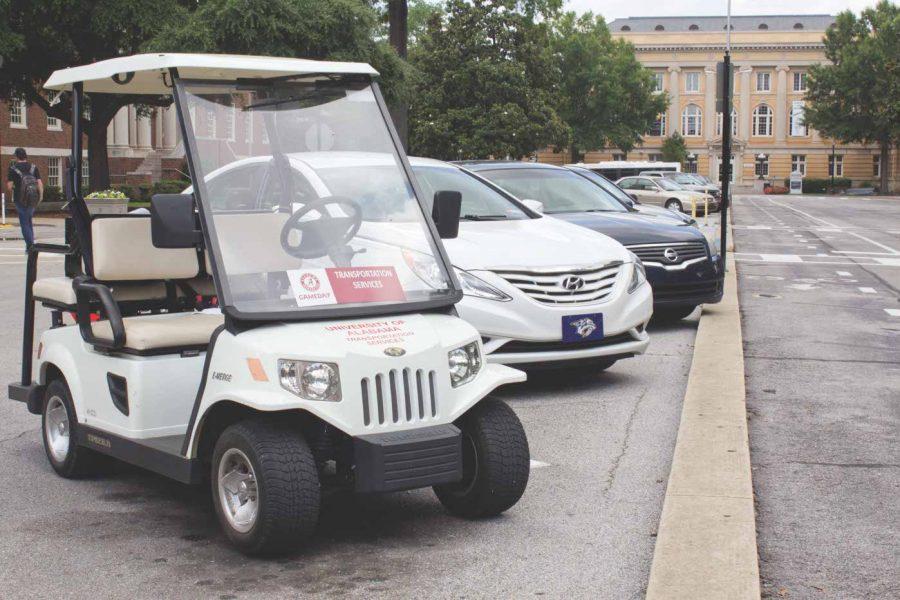Taking into consideration class times, student numbers and historical capacities, parking at The University of Alabama has become a fine science monitored by UA Parking Services.
Chris D’Esposito, director of Parking Services, said certain zones are oversold to ensure efficient use of the University’s parking spots. He said the 23,000 parking passes sold last year for 21,000 available spots is a reflection of the University’s commitment to safe and efficient parking, as well as the product of several factors.
“We base sales on available spaces and historical use of capacity,” D’Esposito said. “We want to provide the highest number of individuals the ability to purchase a permit and still have a parking space.”
He said overturn of parking spaces during the day as students travel to and from campus allows for the oversell of spaces to maximize efficiency of the lots. D’Esposito said that while a student’s first choice for parking may not always be available, alternatives are accessible.
“For example, commuter students can choose the zone that best meets their individual need, but they also have parking access to the Perimeter Zone,” D’Esposito said. “A planning note would be to allow for extra time to find a parking space within your zone Monday and Tuesday and Thursday. Also, parking on campus tends to be the most saturated between the hours of 11 a.m. and 2 p.m.”
Karly Wilson, a first-year graduate student studying political science, said she allots large amounts of time to commute to class because she needs to park at a commuter lot on the periphery of campus and then take the CrimsonRide transit system.
“[The lots] usually are pretty crowded, but I haven’t not been able to get a spot,” she said. “But I usually get here a little early.”
Since commuter lots can be on the periphery of campus, the transit system is a crucial element of parking efficiency and hiccups in the routes can cause the whole system to break down.
“I think the system pretty much works,” Wilson said. “They definitely couldn’t get away with parking lots being as far away as they are without the CrimsonRide.”
When Wilson was a freshman in 2008, CrimsonRide was in its second year and the commuter lot where she parks now didn’t exist. The street where Wilson used to be able to park – though spots were rarely available – is now one-way, with diagonal spaces where parallel parking used to be.
Since then, enrollment has increased by more than 6,000 students, so similar changes can be seen down the street, where the Riverside Parking Deck is nearing completion.
“We are excited to add the Riverside East Parking Deck to the Yellow Residential Parking Zone. While the unseasonable amount of rain has delayed the completion of the deck, we have been granted access to the first floor and will be given floors two through four as they become available,” D’Esposito said. “Once completed, an additional 780 spaces will be available to this zone. We are also pleased to report even with the deck still under construction there is ample parking in the Yellow Residential Parking Zone.”
Data provided by D’Esposito compares sales for permits as recorded on Aug. 20 of 2012 and 2013. Total sales have decreased by just more than 500 passes, from 19,224 to 18,673.
Among red permits, only Red West saw an increase in sales – 1,941 to 1,984 – with Northeast and Southeast decreasing by just more than 200 each. Sales of permits for the Student Perimeter lot decreased from 549 to 521.
Orange and Yellow Residential permit sales both decreased by just more than 150, while Silver Residential permit sales increased by 41 passes. Tan Residential permit sales increased by 11 passes. Overall, 4,686 residential parking permits were sold.
D’Esposito said there is plenty of room for growth on campus but the University is also pursuing more innovative partnerships to provide solutions.
“For example, we have partnered with the City of Tuscaloosa to provide free-of-charge parking at the Downtown Intermodal Facility (601 23rd Ave.). Once parked, simply hop on the Tuscaloosa Trolley, also free of charge, for a ride to campus,” D’Esposito said. “The trolley will make 12 stops on and near campus, one being the UA transit hub. Also, we provide shuttles to numerous apartment complexes in the vicinity. Other apartment complexes have their own shuttle that makes stops at the hub.”









